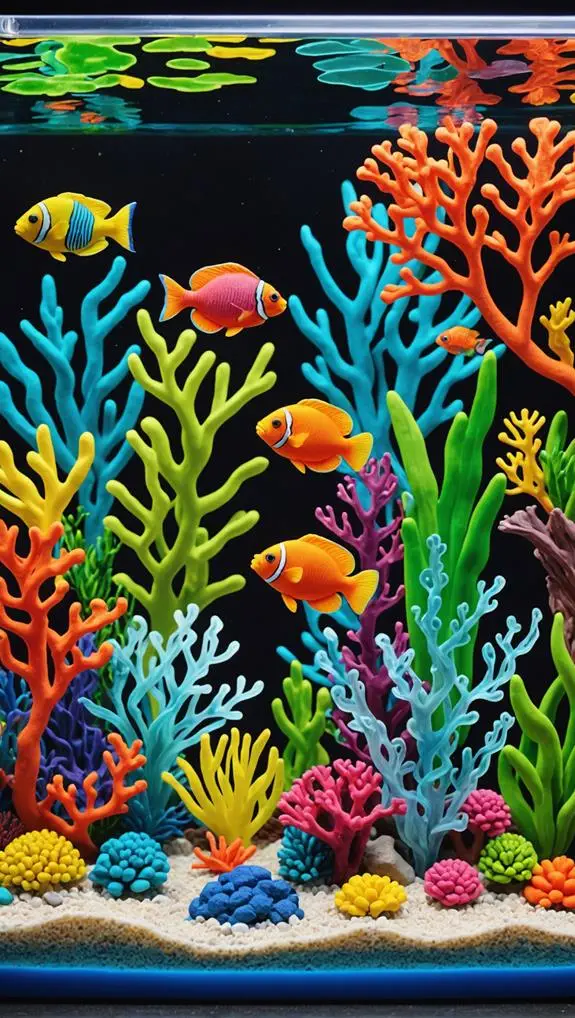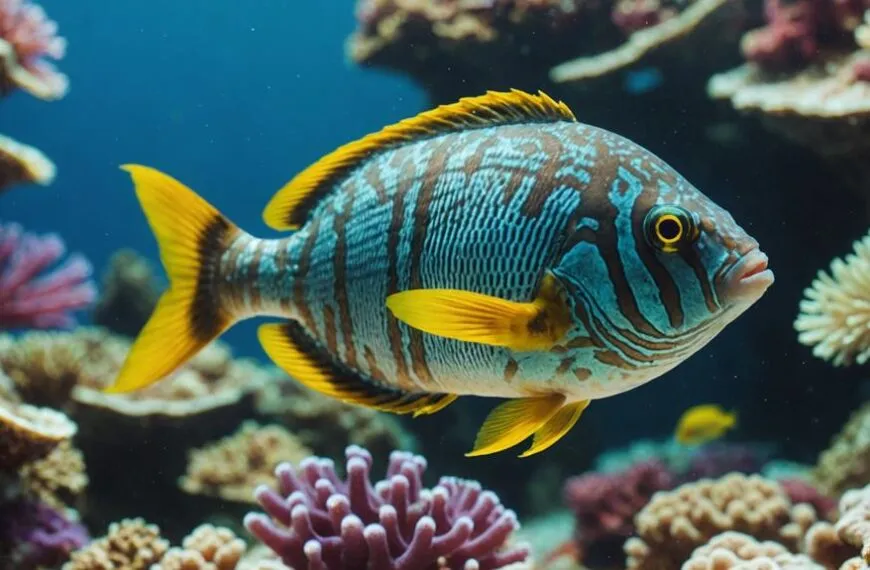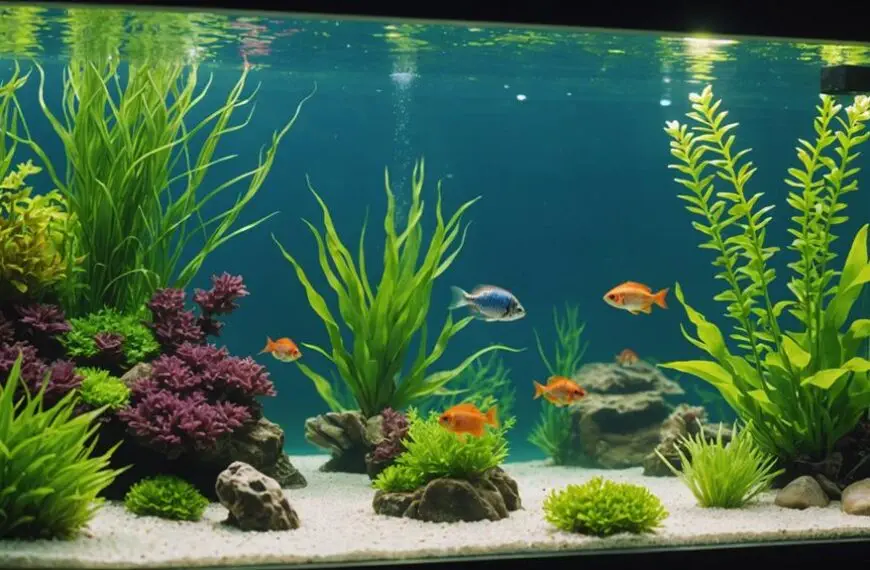To keep your tropical fish happy and disease-free, start by doing regular partial water changes, about 25% each week. This keeps toxins in check. Monitor those water parameters, like ammonia and nitrates, to ensure your aquatic buddies are feeling good. When introducing new fish, acclimate them slowly over a couple of hours to reduce stress. Don't forget about the power of a balanced diet to strengthen their immune systems! And hey, keeping a quarantine tank for newcomers is a smart move to keep your established fish safe. Stick around to learn more tips that will make your aquarium thrive!
Contents
Disease Prevention Strategies
To keep your tropical fish healthy, implementing effective disease prevention strategies is essential. First, focus on water quality. Regular partial water changes of about 25% each week help keep toxins at bay while filter maintenance every six months ensures your fish are swimming in clean, safe water.
Additionally, monitoring key water parameters like ammonia and nitrates is vital to prevent stress and promote fish health.
When you add new fish, don't rush it! Gradually acclimating them over a two-hour period using drip acclimation reduces stress and supports their immune system.
Also, make sure to monitor water parameters like ammonia and pH levels to maintain the best environment for your aquatic friends.
A balanced diet is crucial, too. Feeding your fish the right amount—without overdoing it—will strengthen their immune systems, making them less vulnerable to diseases like Ichthyophthirius multifiliis.
Importance of Quarantine
Quarantine procedures are crucial for maintaining the health of your established aquarium. When you add new fish, it's like inviting guests to a party—you want to make sure they're healthy before they mingle!
Ideally, you should set up a separate 20-gallon, fully cycled, and heated tank for this purpose. For at least 30 days, monitor your new fish closely for any signs of stress or illness. Choosing peaceful species that thrive in groups, such as Neon Tetras, can help create a harmonious community once they join your main tank.
Using designated equipment for your quarantine tank is key. You don't want any cross-contamination ruining your disease-free aquarium! If you spot any health issues, don't hesitate to administer medications right away. Just remember to remove any carbon and chemical media first for effective treatment.
A gradual acclimation process helps reduce stress, making the transition smoother for your new arrivals. Proper care during this period isn't just thoughtful; it's essential for their health.
Water Quality Management

Maintaining a healthy aquarium goes beyond just isolating new fish; water quality management plays a vital role in your tank's overall health. You need to regularly monitor water parameters, including ammonia, nitrites, nitrates, and pH levels. Keeping these in safe ranges helps avoid stress-related diseases in your fish. It's like giving them a cozy blanket of water!
Regular monitoring also promotes stable nitrogen cycles, reducing harmful compounds that can lead to health issues for your aquatic friends. Remember, optimal conditions encourage successful breeding and reduce stress behaviors in fish!
Conducting partial water changes, ideally 25% weekly, is essential. This practice dilutes toxins and maintains optimal water quality, preventing disorders related to poor conditions. Remember to condition tap water before adding it to your tank; it's crucial to eliminate harmful chemicals like chlorine that can stress your fish and affect their immune systems.
Also, maintaining stable water temperatures and adequate dissolved oxygen levels is key. Fluctuations can stress your fish out, leading to disease outbreaks that nobody wants to deal with.
If you have quarantine tanks, use separate equipment for them to prevent cross-contamination. Keeping a close eye on the water quality of both your quarantine and main tanks ensures a healthy environment for everyone.
With proper water quality management, you'll be well on your way to preventing diseases and keeping your aquatic friends happy!
Recognizing Fish Health Issues
Recognizing fish health issues is essential for maintaining a vibrant aquarium. You've got to know what's normal for your fish, so you can spot any changes that might signal trouble.
Watch for symptoms like white spots, cloudy eyes, or ragged fins. These can indicate common diseases that need your attention. If your fish start showing abnormal behavior, like swimming erratically or hiding too much, it's time to take action.
Using visual aids, such as photos or videos, can help you pinpoint specific ailments. Think of it as your fishy detective kit!
And don't hesitate to reach out for a consultation with an expert when you see signs of illness. Early detection is key—catching issues before they escalate can save your aquatic friends from serious health complications.
Stress Reduction Techniques

Creating a peaceful environment in your tropical fish tank is crucial for reducing stress among your aquatic pets. Stress reduction techniques can make a world of difference! Start by adding hiding places, like PVC fittings or plants, which can help reduce aggression from other fish. These cozy spots give your fish a safe refuge, making them feel more secure.
Maintaining a stable water temperature is another key factor. Fish don't like drastic changes, so keep those fluctuations to a minimum. A steady environment can help them thrive and prevent diseases.
Also, be mindful of environmental disturbances. Loud noises or sudden movements near the tank can startle fish, so try to keep things calm and quiet.
When introducing new tropical fish, use gradual acclimation procedures. A drip acclimation method over two hours works wonders. During the acclimation period, consider reducing the intensity of your aquarium lighting. It'll help your fish adjust without feeling overwhelmed.
Frequently Asked Questions
How to Prevent Disease in a Fish Tank?
To prevent disease in your fish tank, quarantine new arrivals, maintain water parameters, perform regular maintenance, select compatible species, feed high-quality food, reduce stress factors, manage tank lighting, and monitor fish behavior closely.
How Do You Keep a Tropical Fish Tank Healthy?
To keep your tropical fish tank thriving, focus on tank maintenance, ensure water quality, establish a feeding schedule, create an inviting environment, optimize lighting, select suitable substrate, and choose compatible tank mates for stress reduction.
How Do I Prevent Bacteria in My Fish Tank?
To prevent bacterial growth in your fish tank, focus on tank cleaning, maintain optimal water parameters, select the right filter, practice substrate maintenance, use live plants, ensure fish compatibility, and follow proper quarantine procedures.
How Do You Boost the Immune System in Aquarium Fish?
Think of your fish as little superheroes! To boost their immune systems, focus on nutrition importance, stable water quality, stress reduction, compatible tank mates, regular maintenance, vitamin supplements, and proper breeding practices. Quarantine new arrivals too!
Final Thoughts
Keeping your tropical fish healthy is a bit like tending a garden; you need to nurture it with care and attention. By focusing on disease prevention, managing water quality, and reducing stress, you're creating a vibrant underwater world where your fish can thrive. Remember, a little extra effort today can save you from bigger troubles tomorrow. So, dive into these practices, and watch your fish flourish like colorful flowers in a sunlit meadow!












